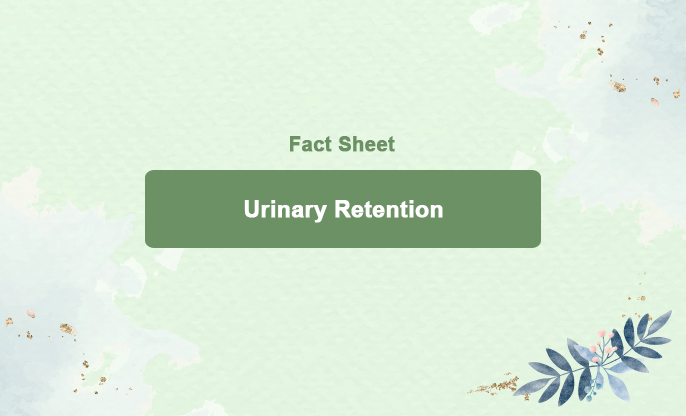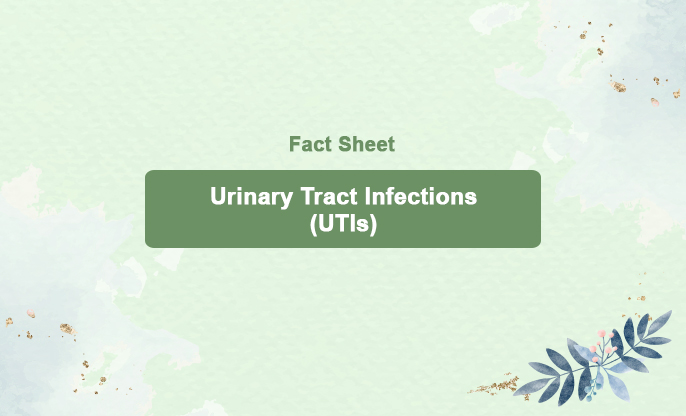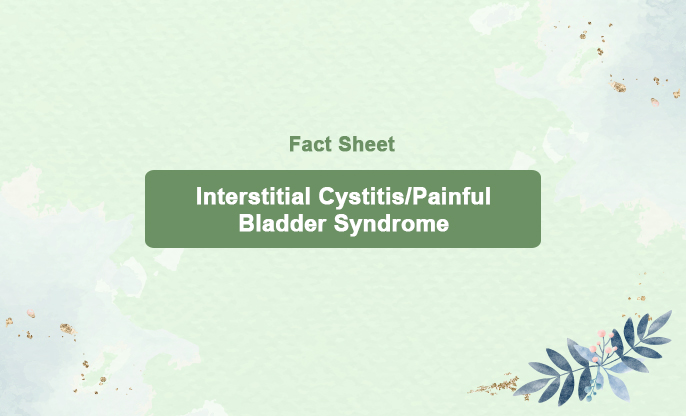
What is this?
Urinary retention is a condition where you cannot completely empty your bladder. It is not a disease but can be associated with other health issues, such as prostate problems in men or a cystocele in women. Urinary retention can be acute, meaning a sudden inability to urinate, or chronic, indicating a gradual difficulty in emptying the bladder.
Acute Urinary Retention
Acute urinary retention occurs suddenly and lasts for a short duration. Individuals with this condition are unable to urinate despite having a full bladder.
This condition can cause severe pain and may be life-threatening. If you suddenly find yourself unable to urinate, it is crucial to seek emergency medical treatment immediately.
Chronic Urinary Retention
Chronic urinary retention develops gradually over time. Individuals with this condition can urinate but cannot completely empty their bladders. Many people with chronic urinary retention may be unaware of the condition, as they often do not experience noticeable symptoms.
Acute urinary retention is common among older men, with its likelihood increasing with age. Over a five-year period, approximately 1 in 10 men over the age of 70 and nearly 1 in 3 men in their 80s will experience acute urinary retention.
In contrast, acute urinary retention is much less common in women, with about 3 in 100,000 women developing the condition each year. It is also rare in children.
The prevalence of chronic urinary retention is not well-documented. However, it is known to affect older men more frequently than any other group.
Symptoms of acute urinary retention may include:
Inability to urinate
Severe pain in the lower abdomen
Urgent need to urinate
Swelling in the lower abdomen
Chronic urinary retention develops gradually and may cause few or no symptoms, making it difficult to detect. If symptoms do occur, they may include:
Inability to completely empty the bladder when urinating
Frequent urination in small amounts
Difficulty starting the flow of urine (hesitancy)
Slow urine stream
Urgent need to urinate with little success
Feeling the need to urinate again shortly after finishing
Unintentional urine leakage without warning or urge
Lower abdominal pain or discomfort
Causes:
Blockage or Narrowing in the Urethra or Bladder Neck
For normal urination, all parts of the urinary tract must function correctly in sequence. Urine flows from the kidneys through the ureters to the bladder and exits via the urethra. If a blockage or narrowing occurs along this pathway, it can cause difficulty urinating or, in severe cases, the inability to urinate.
Medical issues that may narrow the urethra and obstruct urine flow include:
Enlarged prostate (benign prostatic hyperplasia)
Bladder outlet obstruction (e.g., urethral stricture or scar tissue in the bladder neck)
Pelvic organ prolapse (e.g., cystocele and rectocele)
Urinary tract stones (calculi)
Constipation
Pelvic masses (e.g., tumors, fibroids, polyps, or clots)
Tight pelvic floor muscles
Infections (e.g., urinary tract infection, sexually transmitted diseases, prostatitis)
Trauma to the pelvis, urethra, or penis
Inefficient Bladder Contraction (Underactive Bladder)
Urinary retention can occur when bladder muscles cannot contract strongly or long enough to empty the bladder completely, known as an underactive bladder.
Causes of underactive bladder include:
Neurological Problems:
Parkinson’s disease
Multiple sclerosis
Alzheimer’s disease
Stroke
Birth defects (e.g., spina bifida)
Diabetes
Spinal cord injury
Traumatic brain injury
Pelvic injury
Vaginal birth
Guillain-Barré syndrome
Fowler’s syndrome
Heavy metal poisoning
Medications: Certain medications can interfere with nerve signals to the bladder, urethra, or prostate, causing urinary retention. Examples include:
Alpha-adrenergic agonists
Anticholinergics and antispasmodics
Antidepressants
Antihistamines and decongestants
Antiparkinsonian medications
Antipsychotics
Benzodiazepines
Calcium channel blockers
Nonsteroidal anti-inflammatory drugs (e.g., aspirin, ibuprofen)
Opioids
Serotonin and noradrenaline reuptake inhibitors
Surgery: Temporary urinary retention is common after surgery. Intravenous (IV) fluids can lead to a full bladder, and anesthesia can prevent the sensation of needing to urinate. Pelvic surgery can cause swelling, scar tissue, and trauma, obstructing urine flow.
Weak Bladder Muscles: Bladder muscles may weaken and fail to contract with sufficient strength to empty the bladder completely. Causes include:
Age-related muscle weakness
Overdistention (a bladder stretched to the point of muscle damage)
Pregnancy and childbirth
Trauma
Treatment:
Draining the Bladder
For acute urinary retention, a healthcare professional will immediately use a catheter to drain the urine from your bladder, relieving pain and preventing damage to the bladder and kidneys.
For chronic urinary retention, the underlying cause is treated first. If retention persists or becomes severe, a catheter may be used to drain the bladder.
Some individuals may need to use a catheter long-term until the condition is resolved. The catheter can be indwelling (left in the bladder) or intermittent (inserted and removed as needed). Healthcare professionals can teach patients how to use an intermittent catheter.
Medications
5-alpha reductase inhibitors: Shrink the prostate to improve urine flow (e.g., dutasteride, finasteride).
Alpha-blockers: Relax muscles in the bladder neck and prostate to ease urination (e.g., alfuzosin, doxazosin, prazosin, silodosin, tadalafil, tamsulosin, terazosin).
Combination therapy: Using both 5-alpha reductase inhibitors and alpha-blockers for better results.
Antibiotics: Treat infections causing urinary retention (e.g., UTIs, prostatitis).
Adjusting medications: If certain medicines cause retention, doses may be reduced or the medicine discontinued.
Procedures and Devices
Cystoscopy: Uses a cystoscope to remove blockages like stones.
Laser therapy: Uses light to reduce prostate obstruction.
Prostatic urethral lift (UroLift): Implants lift the prostate away from the urethra.
Transurethral electrovaporization: Uses heat to vaporize enlarged prostate tissue.
Transurethral water vapor therapy (Rezum): Uses steam to shrink the prostate.
Urethral dilation: Stretches the urethral opening to treat strictures.
Vaginal pessary: A ring inserted into the vagina to support bladder or rectal prolapse.
Surgery
Prostate reduction: Removes part of the prostate.
Urethral and bladder neck repair: Fixes strictures or scar tissue.
Pelvic organ prolapse repair: Corrects organ prolapse.
Tumor or abnormal uterus removal: Removes obstructions.
Bladder repair: Fixes abnormal bladder.
Urinary diversion: Reroutes urine flow out of the body.
How to avoid it?
Regular Check-ups:
Schedule regular medical check-ups, especially if you are at risk for conditions like an enlarged prostate.
Monitor Urinary Habits:
Pay attention to changes in your urinary habits and seek medical advice if you notice difficulties.
Stay Hydrated:
Drink plenty of water to help maintain a healthy urinary system.
Healthy Diet:
Maintain a balanced diet rich in fiber to prevent constipation, which can contribute to urinary retention.
Pelvic Floor Exercises:
Practice exercises like Kegels to strengthen pelvic muscles.
Manage Chronic Conditions:
Effectively manage chronic conditions like diabetes and neurological disorders to reduce the risk of urinary retention.
Medications:
Review your medications with your healthcare provider to identify any that may cause urinary retention and discuss alternatives if necessary.
Avoid Bladder Irritants:
Limit intake of caffeine, alcohol, and spicy foods that can irritate the bladder.
Timed Voiding:
Practice timed voiding (urinating at regular intervals) to help retrain your bladder.
Healthy Lifestyle:
Maintain a healthy weight, avoid smoking, and engage in regular physical activity to support overall bladder health.
Prompt Medical Attention:
Seek prompt medical attention for urinary tract infections or any symptoms of urinary retention to prevent complications.




